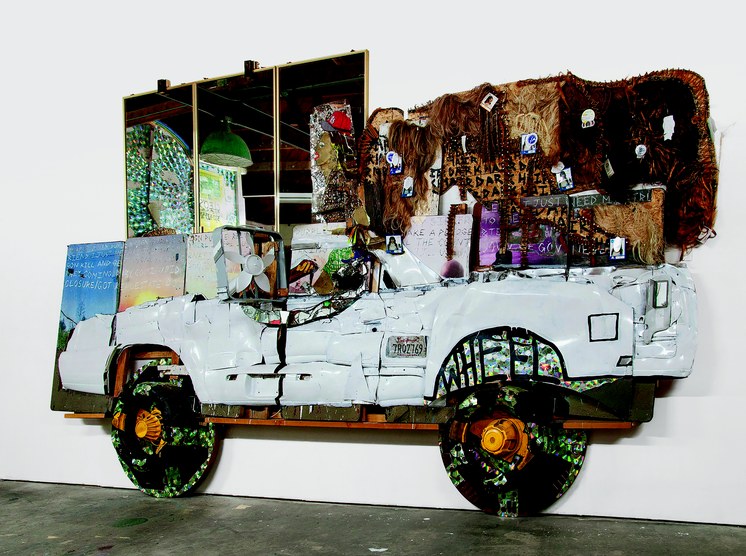A museum biennial, a group exhibition staged every two years, is a thankless task. The Whitney gets savaged regularly for some aspect of their long-lived biennial but they are doubly dogged by choosing artists from the around the country to show in one of the country’s first museums dedicated to American art.
The Hammer Museum in Westwood started their series of biennials just eight years ago and smartly decided to keep the focus on Los Angeles. Not only does this eliminate the long simmering resentment about artists from New York or Europe receiving more favorable treatment here than locals, it supports the indisputably impressive and expanding L.A. art scene.
Made in L.A. 2018 is a particularly successful iteration.
Hammer senior curator Anne Ellegood with Erin Christovale, the newest curator at the museum, visited some 200 studios to chose the 33 artists and temporarily stored the Hammer’s permanent collections so that the entire building could be devoted to the show. In addition, the newly opened Nimoy studio by architect Michael Maltzan adds space for performance and other events, a continuation of his now 18-year committment to architectural alterations of the museum.
Eamon Ore-Giron, Top Ranking, 2015. Flashe on linen. 66 x 56 in. (167.64 x 142.24 cm). Private collection. Courtesy the artist.
But back to Made in L.A. 2018, which is a pretty good effort and uncontestably diverse. Most artists opted to maximize their positions beginning with Eamon Ore-Giron whose entrance hall mural, Angelitos Negros, combines unexpected alliances of geometric forms and spunky color. It is a dazzling introduction to the show.
Carmen Argote, Filtration System for a process-based practice, 2018. Photo by Hunter Drohojowska-Philp.
Guadalajara-born Carmen Argote may have the largest single work, a fiberglass mound covered in raw canvas that was painted with thin drips of colored paint poured over the surface.
It refers to the color field paintings of artists like Morris Louis but her source is an odd concrete hemisphere positioned in Lincoln Park Lake. Part of her “Filtration System for a process- based practice,” it smartly integrates quotidian life with accepted ideas about art of the mid-20th century.
Rosha Yaghmai, Slide Samples (Lures, Myths) 2018. Photo by Hunter Drohojowska-Philp
Similarly, Rosha Yaghmai’s 2018 installation of a standing screen divided by mullions that contain sheets of translucent poured resin or personal objects is illuminated to magical effect.
Soft pastel light dances through the darkened space. Small personal objects, some of them incongruous such as hanging fishing lures, cast shadows. Titled Slide Samples (Lures, Myths), it uses photographic slides taken by her father, who immigrated to California from Tehran to study architecture. The piece is not literal but impressionistic about the integration of experience, memory and the past.
Aaron Fowler, El Camino, 2017. Acrylic paint, enamel paint, car parts, hair weave, mirrors, CDs, fans, fitted cap, tires, poker tables, speakers, digital printout, and concrete cement on conference tables. 132 x 168 x 48 in. (335.3 x 426.7 x 121.9 cm). Courtesy the artist.
Aaron Fowler, who moved to L.A. after his successful show at Diane Rosenstein Gallery in 2016, has nearly covered one wall with El Camino (2017), his larger than life-sized wall relief of the white truck combined with a covered wagon and loaded to the top with memories, hand-written observations, sheets of plate glass mirror, chopped up CDs, and swags of dark brown hair weaves. The artist has arrived!
From the outset, museum officials decided to embrace a multi- generational approach, drawing attention to generations of older artists who choose to teach as well as their former students.
Charles Long, Paradigm Lost, 2018 (detail). Photo by Hunter Drohojowska-Philp
Charles Long is well-known for his 1990s-era sculptures addressing aspects of modernist sculpture with the shapes of the human body. Since moving here from the East Coast in 2000, his work changed. For the Hammer, he created a wild, weird and wonderful installation of towering cliffs and fat bone-white tree stumps as a dark scene of deforestation that is being visited by aliens. Flattened cross sections of logs are twisted into the Munch’s screaming face. A stained glass window shines down upon the tragicomic scene further affected by John Hiler’s sound installation.
In addition, curators have rediscovered artists who have fallen off the radar but whose talents still deserve recognition.
Luchita Hurtado, Untitled, 1970. Oil on canvas. 30 x 50 in. (76.2 x 127 cm). Signed and dated on verso. Courtesy the artist and Park View/Paul Soto, Los Angeles and Brussels. Photo: Cole Root.
Luchita Hurtado a.k.a. Luchita Mullican, 97, is represented by paintings from the 1960s and 1970s. Her Surrealistic landscapes of the New Mexican high desert echo the visionary work of Georgia O’Keeffe and the Transcendentalists.
One of the more interesting aspects of these biennials is the diversity of both critical and popular responses. There is so much more than can be addressed by any single observer and there are numerous performances and events taking place at the Hammer over the next few months. Especially promising are the talks by artists on artists, all of whom are included in the exhibition. Made in L.A. 2018 lives up to the curators’ goal of making an exhibition that “argues for complexity, thoughtfulness, and ambiguity….”
It continues through Sept. 2.
